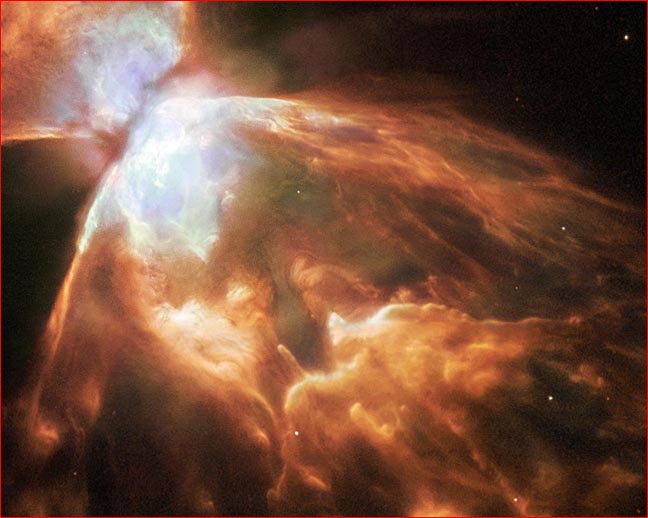
home •
about •
essential guide •
picture of the day •
thunderblogs •
news •
multimedia •
predictions •
products •
get involved •
contact
picture of the day archive subject index
Above: NGC 6302, the Bug Nebula, displaying the “z-pinch” so familiar to plasma cosmologists. The pinching of a
plasma cloud into a narrow “neck” is just one of numerous indicators of high-energy electric currents. The star at
the center of the pinch is hidden from view by a donut-like cloud or torus, another pattern typical of plasma
discharge instabilities.
Credit: A. Zijlstra (UMIST) et al., ESA, NASA
Dec 30, 2005
The Electric Universe—A Status ReportAsk a proponent of the “Electric Universe” or “Plasma Universe” about the state of astronomy today, and you will likely be greeted by exasperation. “How do you get specialists, who are so preoccupied with deductions from earlier assumptions, to step back far enough to see that their hypothesis fails at its root?”
The progress of scientific discovery in the space age has followed a now-predictable pattern: New instruments detect new phenomena that surprise theoreticians, who say the discovery will require new thinking, but who propose mere rewordings of the same old thoughts. The only appropriate test of a theoretical model is predictive ability, and on this test the record of conventional science stands at near zero. Every milestone, every dramatic new finding, astonishes investigators
To understand the confidence of the electrical theorists, you have to apply the same test. Did the great discoveries come as surprises? How many expectations of the electric model—expectations that undeniably separate the electric model from the standard view—have NOT been found? The cosmic electricians will tell you that the empirical tests have already been decided in favor of electricity—
The presence of magnetic fields throughout space, the definitive signature of electric currents.
Pervasive filamentation of space plasma, an observed attribute of electric currents in plasma but contrary to the expected behavior of neutral gases in a vacuum.
Laboratory experiments with and computer simulations of the electrical behavior of plasma that successfully replicate the elaborate structures now revealed in space.
The continuing failure of the Big Bang model to justify its underlying assumption that redshift is invariably an indicator of distance; and in particular the standard exclusion of plasma discharge, a proven source of intrinsic redshift, ejection, element generation and separation, and large-scale organization of matter.
Acceleration of charged particles away from the Sun, REQUIRING an electric field centered on the Sun.
Electromagnetic forces evident in the principal features of the Sun—sunspots, granulation, prominences, coronal heat, flares, mass ejections and more.
The astonishing discoveries about comets—jets, surface relief, absence of water, fine powder, x-rays—explained coherently by electric models even as conventional comet theory has fragmented into contradictory hypotheses and guesses.
The dominant surface features on rocky planets and moons, which conform in detail with electrical discharge scarring but are anomalous for traditional geological processes.
A cascade of new evidence, such as megalightning, establishing the electrical connection of the Earth to surrounding space and to the Sun.
To make the advantage of the unified electric model as clear as possible, we shall begin the New Year with a series of overviews, with links to previous Pictures of the Day and pointers to new findings that will be covered in these pages during the coming year.
________________________________________________________________________________________________Please visit our Forum
The Electric Sky and The Electric Universe available now!

|
|

|
EXECUTIVE EDITORS:
David Talbott, Wallace Thornhill
MANAGING EDITOR: Amy Acheson
CONTRIBUTING EDITORS: Mel Acheson, Michael Armstrong, Dwardu Cardona,
Ev Cochrane, C.J. Ransom, Don Scott, Rens van der Sluijs, Ian Tresman
WEBMASTER: Michael Armstrong
Copyright 2005: thunderbolts.info
![]()
home •
thunderblogs •
forum •
picture of the day •
resources •
team •
updates •
contact us

